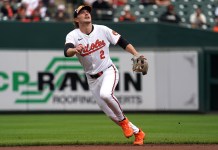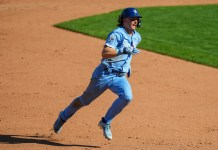MLB shift ban could alter offense in multiple ways
The seemingly endless tinkering with the game of baseball has left bettors scrambling at the start of each new season. It takes a pretty significant sample size of data to decide whether or not something is real or just variance, but there are some things we can assume about the shift ban as the 2023 season plays out.
Top MLB Resources:
Will the shift ban mean fewer home runs?
One interesting early return is that batted ball distance and launch angle are down in the early going. Publicly available Statcast data goes back to 2015. Throughout that time, the frequency of the shift has grown and grown. As a result, many teams decided to suggest to their players to hit the ball in the air to try and drive it over the shift. That led to the lowest batting averages we’ve seen since the 1960s and a lot of home runs, strikeouts and walks.
The ban on the shift has already had an impact on both launch angle and batted ball distance for this season.
Here are the batted ball distances (feet) and launch angles (degrees) in the Statcast era:
2015: 169 / 10.9
2016: 171 / 11.6
2017: 172 / 11.8
2018: 171 / 12.3
2019: 174 / 12.7
2020: 168 / 12.7
2021: 166 / 12.6
2022: 165 / 12.7
2023: 161 / 12.0
If I limit the data to March/April in the sample size, the distance differences are nominal from the previous years and some were even deeper than the full-season numbers. This has nothing to do with the cold weather. To me, this has to do with a fundamental change in approach for batters without the shift.
The early returns on the 2023 season show the highest GB% since 2017. They also show the highest Pull% in that sample size at 41.9%. Hitters are not shying away from pulling the ball and are not trying to elevate it as much.
Are we seeing more hits? Yes and no. The high K% of the early season lowered batting averages with the aces and above average starters on the mound, but as teams got to face the back end of the rotation, offense exploded (Monday). The league-wide BABIP is up over the past few seasons at .298 and closer to what we saw from 2015-19 when the shift wasn’t as prevalent.
I’m curious to see if this trend sticks because I do think hitters will ultimately try to adjust and pull the ball in the air. Hitting with men in scoring position is still hard because of the high-strikeout environment and driving the ball for power is the best elixir for that ailment.
Rebirth of the platoon advantage?
One potentially huge gambling development I’ll be following is the possible return of the platoon advantage. Smart teams in the 1990s and 2000s realized that hitters have big advantages based on the handedness of the pitcher and the hitter. Teams would try to cobble together a productive player by using a left-handed batter against a right-handed pitcher and a right-handed batter against a left-handed pitcher.
This was a good way of saving money because platoon players are flawed, in that they are really only going to be effective some of the time. While big-ticket free agents with high salaries and lofty statistics cost a lot of money, you can take two players and combine them to create a cheaper version of a great player by playing to each one’s strengths.
The platoon really had its heyday in the mid-2000s. From 2002-08, left-handed batters against right-handed pitchers hit at least .271 every year. With the rise in shifts, that advantage started to go away in some respects. Rising strikeout totals didn’t help, but by 2013, the batting average in that split fell below .260. By 2018, the batting average was down to .251.
It has gotten dire over the last few seasons. I talked about the death of the platoon advantage on my old podcast, The Bettor’s Box, a few years ago and how it forced me to make a big adjustment with day-to-day betting, but I never thought it would get as bad as it has.
Look at these numbers (BA/OBP/SLG) on a yearly basis by comparison:
2015: .259/.329/.418
2016: .257/.331/.426
2017: .260/.336/.440
2018: .251/.330/.423
2019: .254/.331/.444
2020: .239/.324/.411
2021: .243/.324/.417
2022: .239/.314/.394
2023: .242/.332/.430
Arguably the most telling stat for me is Pull%, which is the percentage of batted balls pulled by left-handed batters against right-handed batters. That number is 45.4% through the first five days worth of games. That number has not been higher than 41% in the Statcast era.
Pulled balls not only create more hits due to higher exit velocity, but also produce more power. We’re trending towards the highest LHB vs. RHP slugging percentage since the juiced ball season of 2019. Slugging percentage is (Total Bases / At Bats). If we see an increase in hits from the shift ban, along with what could be a return to normalcy in the launch angle department as the summer months go along, we’re likely to see the return of the platoon advantage.
What that means from a betting standpoint is that right-handed pitchers who have struggled against left-handed batters will continue to do so and likely to a higher degree. It also means that some righties may wind up struggling more with lefties, especially pitchers that tilt towards the ground ball side.
It’s still early and none of this data is really large enough to be considered statistically significant, however it does appear to be on its way to confirming some of my suspicions and creating more offense as MLB intended.




